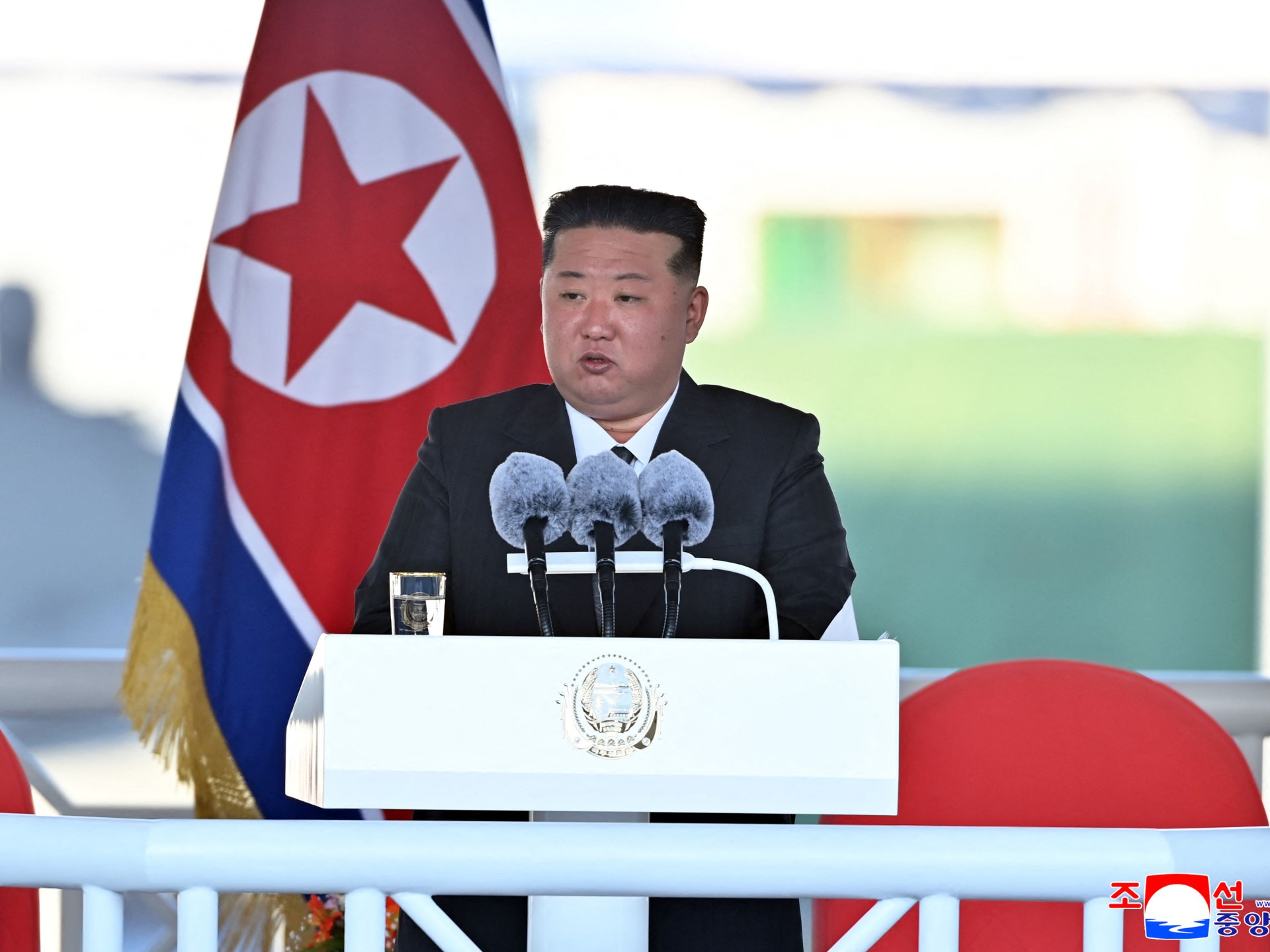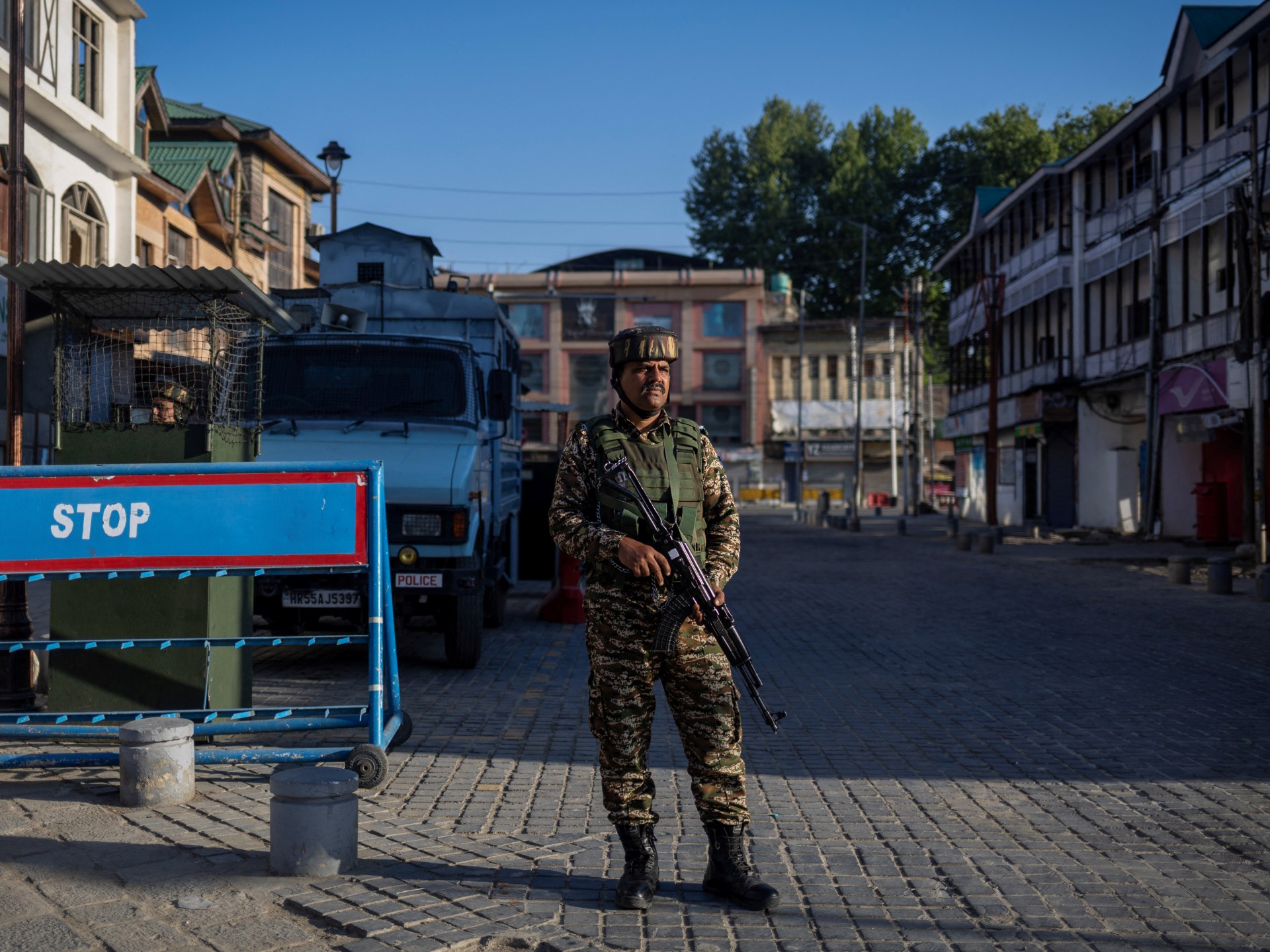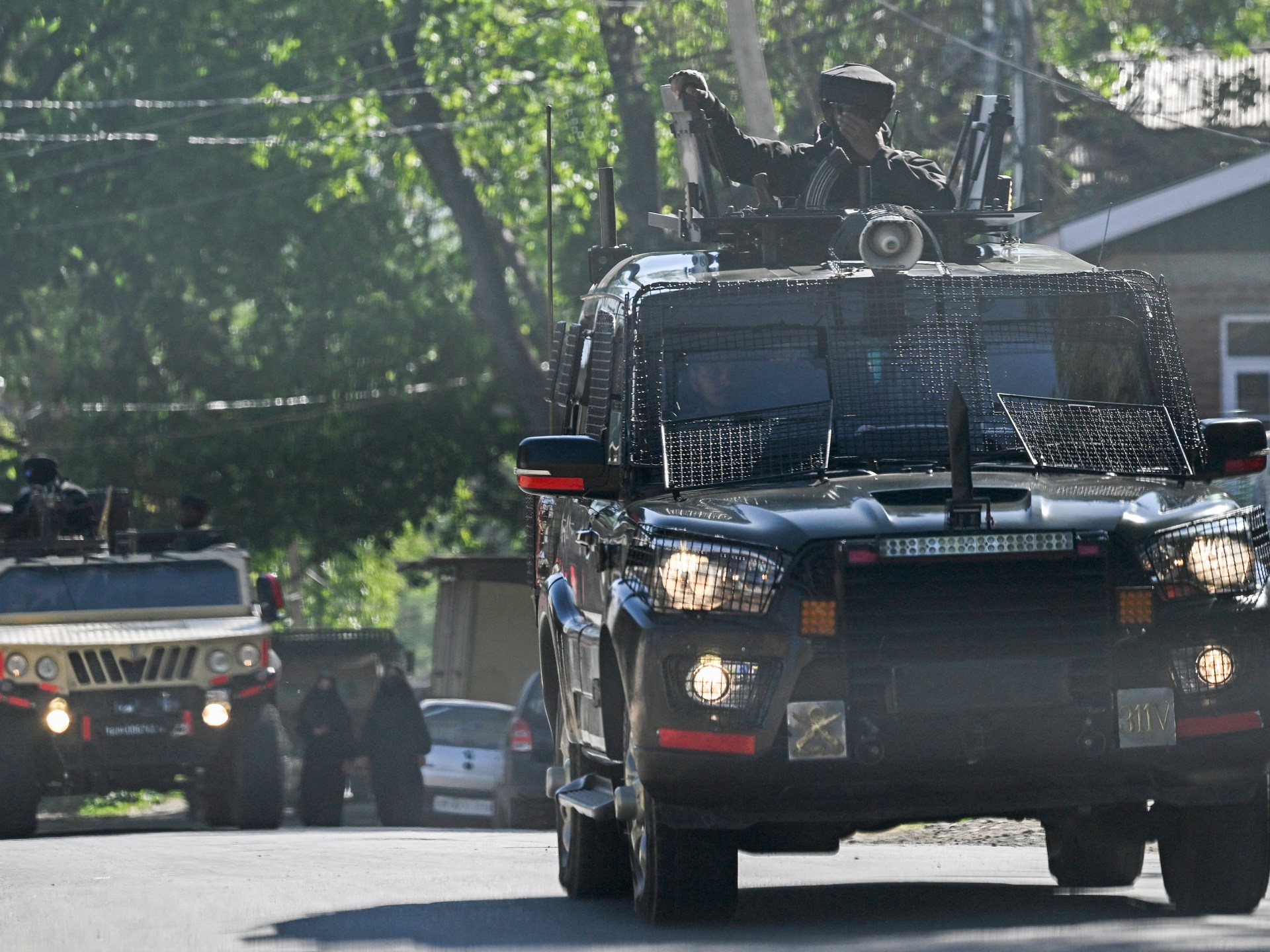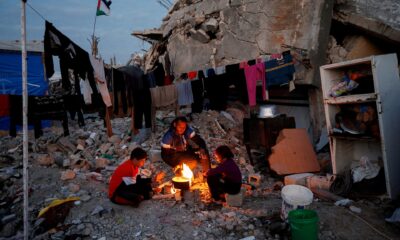Conflict Zones
About 600 North Korean soldiers killed in war in Ukraine, lawmakers say | Russia-Ukraine war News

South Korean lawmakers provide update on estimated casualties following briefing by country’s intelligence agency.
About 600 North Korean soldiers have been killed fighting in Russia’s war in Ukraine, South Korean lawmakers have said, citing intelligence officials.
Speaking after a closed-door briefing by the National Intelligence Service (NIS) on Wednesday, Lee Seong-kweun and Kim Byung-kee told reporters that an estimated 4,700 North Koreans had been killed or injured so far in the war.
Lee and Kim, who co-chair the legislature’s intelligence committee, made their comments two days after Pyongyang confirmed for the first time that it had sent troops to Russia to support Moscow’s war.
In a report by the official Korean Central News Agency (KCNA) on Monday, North Korean leader Kim Jong Un was quoted as saying he had ordered the deployment of troops to “annihilate and wipe out the Ukrainian neo-Nazi occupiers and liberate the Kursk area in cooperation with the Russian armed forces”.
The latest casualty figures mark a significant jump from the NIS’s briefing to lawmakers in January, when the spy agency reportedly said that about 300 North Korean troops had been killed in the conflict.
In their briefing to reporters, Lee and Kim, members of the conservative People Power Party and liberal Democratic Party, respectively, said that the NIS estimates that Pyongyang has deployed about 15,000 soldiers in total.
The lawmakers also said that Pyongyang appears to have received technical assistance on spy satellites in return for its assistance, as well as drones, electronic warfare equipment and SA-22 surface-to-air missiles.
“After six months of participation in the war, the North Korean military has become less inept, and its combat capability has significantly improved as it becomes accustomed to using new weapons such as drones,” Lee told reporters.
Conflict Zones
Kashmir attack: How India might strike Pakistan – what history tells us | Border Disputes News

Pakistan said on Wednesday that it had “credible intelligence” that India might launch a military strike against it within the next few days.
Meanwhile, Indian Prime Minister Narendra Modi led a series of security meetings on Tuesday and Wednesday, adding to speculation of an impending Indian military operation against its archrival, after the April 22 attack on tourists in Pahalgam in Indian-administered Kashmir in which 26 people were killed.
Since the attack, barely existent relations between the nuclear-armed South Asian neighbours have nosedived further, with the countries scaling back diplomatic engagement, suspending their participation in bilateral treaties and effectively expelling each other’s citizens.
The subcontinent is on edge. But how imminent is an Indian military response to the Pahalgam killings, and what might it look like? Here’s what history tells us:
What happened?
Pakistan’s Information Minister Attaullah Tarar said in a televised statement early on Wednesday that Islamabad had “credible intelligence” that India was planning to take military action against Pakistan in the “next 24 to 36 hours”.
Tarar added that this action would be India’s response on the “pretext of baseless and concocted allegations of involvement” in Pahalgam. While India has alleged Pakistan’s involvement in the Pahalgam attack, Islamabad has denied this claim.
India and Pakistan each administer parts of Kashmir, but both countries claim the territory in full.
Tarar’s statement came a day after Modi gave the Indian military “complete operational freedom” to respond to the Pahalgam attack in a closed-door meeting with the country’s security leaders, multiple news agencies reported, citing anonymous senior government sources.
On Wednesday, Modi chaired a Cabinet Committee on Security meeting, the second such meeting since the Pahalgam attack, state-run Doordarshan television reported.
Meanwhile, as the neighbours continued to exchange gunfire along the Line of Control (LoC) dividing Indian and Pakistan-administered Kashmir, other world leaders stepped up diplomacy to calm tensions.
“We are reaching out to both parties, and telling … them to not escalate the situation,” a United States state department spokesperson told reporters on Tuesday, quoting US Secretary of State Marco Rubio, who is expected to speak to the foreign ministers of India and Pakistan.
Also on Tuesday, the spokesperson for United Nations Secretary-General Antonio Guterres said that he had spoken to Pakistan Prime Minister Shehbaz Sharif and Indian Foreign Minister Subrahmanyam Jaishankar, offering his help in “de-escalation”.
What military action could India take?
While it is unclear what course of action India could take, it has in the past used a range of military tactics. Here are some of them:
Covert military operations
By design, they aren’t announced – and aren’t confirmed. But over the decades, India and Pakistan have each launched multiple covert raids into territory controlled by the other, targeting military posts, killing soldiers – and on occasion beheading the enemy’s troops.
These strikes are often carried out as a retaliatory step by a military unit whose personnel were themselves previously attacked, as a form of retribution.
But such raids are never confirmed: The idea is to send the other country a message but not force it to respond, thereby containing the risk of escalation. Public announcements lead to domestic pressure on governments to hit back.
Publicised ‘surgical strikes’
Sometimes, though, the idea is not to send subtle messages – but to embarrass the other country by making an attack public. It also doesn’t hurt politically.
India has in the past carried out so-called surgical strikes against specific, chosen targets across the LoC – most recently in 2016.
Then, after armed fighters killed 17 Indian soldiers in Uri, Indian-administered Kashmir, special forces of the Indian Army crossed the de facto border to attack “launch pads” from where, New Delhi alleged, “terrorists” were planning to strike India again. “The operations were basically focused to ensure that these terrorists do not succeed in their design of infiltration and carrying out destruction and endangering the lives of citizens of our country,” Lieutenant General Ranbir Singh, then the director-general of military operations for the Indian Army, said in a public statement, revealing the raid.
India claimed that the surgical strike had killed dozens of fighters, though independent analysts believe the toll was likely much lower.
Aerial strikes
In February 2019, a suicide bomber killed 40 Indian paramilitary soldiers in Pulwama in Indian-administered Kashmir, weeks before national elections in the country. This attack was claimed by the Jaish-e-Muhammad, an armed group based in Pakistan.
Amid an outpouring of rage, the Indian Air Force launched an aerial raid into Pakistan-administered Kashmir. India claimed it had struck hideouts of “terrorists” and killed several dozen fighters.
Pakistan insisted that Indian jets only hit a forested region, and did not kill any fighters. Islamabad claimed it scrambled jets that chased Indian planes back across the LoC.
But a day later, Indian and Pakistani fighter jets again engaged in a dogfight – this one ending with Pakistan downing an Indian plane inside territory it controls. An Indian fighter pilot was captured, and returned a few days later.
Attempts at taking over Pakistan-controlled land
Over the past few years, there have been growing calls in India that New Delhi should take back Pakistan-administered Kashmir. That chorus has only sharpened in recent days after the Pahalgam attack, with even leaders of the opposition Congress Party goading the Modi government to take back that territory.
While retaking Pakistan-administered Kashmir remains a policy objective of every Indian government, the closely matched military capabilities of both sides make such an endeavour unlikely.
Still, India has a track record of successfully taking disputed territory from Pakistan.
In 1984, the Indian Army and Indian Air Force launched Operation Meghdoot, in which they rapidly captured the Siachen glacier in the Himalayas, blocking the Pakistan Army from accessing key passes. One of the world’s largest non-polar glaciers, Siachin has since been the planet’s highest battleground, with Indian and Pakistani military outposts positioned against each other.
Naval missions
In the aftermath of the Pahalgam attack, the Indian Navy announced that it had carried out test missile strikes.
“Indian Navy ships undertook successful multiple anti-ship firings to revalidate and demonstrate readiness of platforms, systems and crew for long range precision offensive strike,” the navy said in a statement on April 27.
“Indian Navy stands combat ready, credible and future ready in safeguarding the nation’s maritime interests anytime, anywhere, anyhow.”
Many analysts have suggested that the trials were a show of strength, pointing to the Indian Navy’s ability to strike Pakistani territory if ordered to do so.
A full-blown military conflict
India and Pakistan have gone to war four times in the 78 years of their independent existence. Three of these armed conflicts have been over Kashmir.
Two months after the British colonial government left the subcontinent in August 1947 after carving it up into India and Pakistan, the neighbours fought their first war over Kashmir, then ruled by a king.
Pakistani militias invaded Kashmir to try and take control. The king, Hari Singh, pleaded with India for help. New Delhi agreed, and joined the war against Pakistan, but on the condition that Singh sign an instrument of accession, merging Kashmir with India. The king agreed.
The war finally ended on January 1, 1949, with a ceasefire agreement. India and Pakistan have both held parts of Kashmir since then.
In 1965, a clash between their border forces escalated into a full-blown war. Pakistani forces crossed the ceasefire line into Indian-administered Kashmir, while Indian forces crossed the international border into Pakistan’s Lahore and launched attacks. After thousands of casualties on both sides, a United Nations Security Council resolution helped the neighbours end the war.
In 1971, Pakistan and India were embroiled in an armed conflict over East Pakistan, where Indian forces helped liberate the territory, leading to the establishment of Bangladesh. In 1972, the two countries signed the Simla Agreement, which established the LoC.
In 1999, the Pakistani military crossed the LoC, sparking the Kargil War. Indian troops pushed the Pakistani soldiers back after bloody battles in the snowy heights of the Ladakh region.
Conflict Zones
‘Exiled’: India-Pakistan families split as border shuts over Kashmir attack | India-Pakistan Partition

Attari-Wagah border crossing, India — It was time to say goodbye. Standing under the searing sun, Saira, wearing a black net burqa, tightly held her husband Farhan’s hand, trying to stay together for a few more moments at the main border checkpoint between India and Pakistan.
Named after Attari village on the Indian side and Wagah across the border, this crossing has for years served as one of the few gateways for people to travel between the neighbours. But the Attari-Wagah border is now the latest place where India and Pakistan divide their citizens, including thousands of families with some members who are Indian, and others Pakistani.
Saira and Farhan had travelled overnight from New Delhi, with their nine-month-old boy Azlan tucked in his mother’s lap after India ordered almost all Pakistani citizens to leave the country by Tuesday, following a deadly attack in Pahalgam in Indian-administered Kashmir that Prime Minister Narendra Modi’s government has blamed on Pakistan. Islamabad has denied the allegation.
Like thousands of other couples, Saira, from Karachi, fell in love with New Delhi’s Farhan on Facebook three years ago. They were married, and Saira moved to New Delhi.
But as Saira and Farhan looked at each other on Tuesday, their eyes moist, a border guard rushed them to get on with it. At the checkpoint guarded by barbed wire and barricades, their only identity is the one defined by the colours of their passports: Saira’s green and Farhan’s blue.
“We shall meet soon,” Farhan told Saira, as he kissed his infant son’s cheeks, preparing for Saira and Azlan to step across the border. “Insha Allah, very soon. I will pray for you both.”
But then a guard stepped forward, pointing to Azlan’s passport. It was blue. “Not the baby, madam,” he told Saira, as she held her son in her left arm.
Before they could fully comprehend what was happening, the couple had been separated: Saira, on her way back to Karachi; Farhan and their breastfeeding child, Azlan, to New Delhi.
![The Attari-Wagah border crossing, seen from the Indian side, on April 29, 2025 [Yashraj Sharma/Al Jazeera]](https://www.aljazeera.com/wp-content/uploads/2025/04/Checkpost-1746001588.jpg?w=770&resize=770%2C578&quality=80)
‘An exile state of life’
On April 22, armed men shot 26 civilians dead, mostly tourists, in the resort town of Pahalgam. Since then, the countries have been on edge. India has blamed Pakistan for the attack; Islamabad has rejected the charge and has called for a “neutral investigation”.
The nuclear-armed neighbours have exchanged gunfire for six days in a row along their disputed borders. India has suspended its participation in the Indus Waters Treaty (IWT), a key water-sharing pact. Pakistan has threatened to walk out of other bilateral agreements. Both nations have trimmed diplomatic missions and, in effect, expelled most of each other’s citizens. The Attari-Wagah border now stands closed for movement or trade.
So far, an estimated 750 Pakistani passport holders have crossed back across the border since April 22, while about 1,000 Indians have returned from the other side. Those affected include a Pakistani woman who was visiting her mother’s home after two decades, two sisters who came for a wedding in India next week but have had to go back without attending the event, and elderly Pakistani patients with deadly ailments they had hoped to have treated in India.
There was also 48-year-old Haleema Begum, who travelled for two days from Odisha on the eastern coast, covering more than 2,000km (about 1,250 miles), to reach the border crossing.
Haleema left her home in Karachi 25 years ago, when she married a small businessman in Odisha. Life, she said, had mostly been fine before a policeman delivered the Indian government’s “Leave India” notice.
“I was so scared. I told them that I did not just come here, I was married off in India,” she said, sitting in a taxi near the border, her cab loaded with dozens of bags. “Is it fair of the [Indian] government to uproot my life and push me out?” Haleema lamented. After spending a quarter of a century in India, she said, the country is her home as well.
Haleema was accompanied by her two sons, 22-year-old Musaib Ahmed and 16-year-old Zubair Ahmed. Her husband passed away eight years ago. The children decided that Zubair would cross over with their mother to take care of her.
But both the children have blue passports, unlike their mother’s green one. They pleaded, then argued, with the border guards. Nothing worked. “She has never travelled alone, I do not know how she will do this,” Musaib said, referring to Haleema’s upcoming 1,200km journey to Karachi.
Once she gets to Karachi, Haleema does not have a home to go to.
“My parents died long ago,” she said, adding that her only brother lives with his family of six in two rooms. “There are 1,000 questions in my mind,” she added, wiping her tears. “And no answers. I just pray to God for the safety of children. We will reunite soon.”
Suchitra Vijayan, the author of Midnight’s Borders, a 2022 book that follows people divided by overnight borders, said the Indian subcontinent “is marked by many, many, of these very heartbreaking stories”.
Since the partition of British India, Vijayan noted, Muslim women from India or Pakistan who married men from the other country and moved there have been among the most affected. The dilemma is perpetual, she said, especially when they are forced to return. “You’re caught in a place that is no longer your home — or it’s a home that you don’t recognise. And exile becomes your state of life.”
Over the decades, many of the families divided by India-Pakistan tensions have held on to hopes — much like Saira and Farhan — that they will be able to reunite soon, she said. Often, that is not how it actually plays out for them.
“One of the most painful things you will listen to repeatedly is that a lot of people thought that they were just leaving temporarily,” she said.

‘Only a mother knows the pain’
Back at the Attari-Wagah border, Farhan pretended his son’s feeding bottle was a plane, hoping to distract his son from the family’s tragedy. “He does not like the bottle; he knows his mother’s touch,” said Farhan’s sister Nooreen, as the boy grew frustrated. Nooreen and other members of the family had joined the couple and Azlan at the border.
“Two big countries and powers are fighting, and our innocent children are trapped. Damn them,” she said. “Only a mother knows the pain of leaving behind a nine-month-old.”
Then, suddenly, Farhan’s eyes lit up when he heard a guard shouting out his name. Wearing a navy blue cotton T-shirt, Farhan sprinted with Azlan’s blue passport in his hands. “Finally, they had mercy on our family,” said Farhan, running hastily, with a timid smile on his face — guards, he thought, had agreed to let Azlan cross with his mother.
But he returned an hour later, his eyes tearful, and his son, irritated by the heat, still in his arms.
“She fell unconscious when she was about to cross the border. Officers told me she would not stop crying [when she regained consciousness],” Farhan said, his words fumbling as he spoke of Saira.
To calm her down, the Indian guards facilitated one last meeting between Saira, her husband and son.
An inconsolable Farhan remarked how different life was before the order that compelled Saira to leave the country. Farhan is an electrician in the centuries-old part of the Indian capital, known as Old Delhi. Saira, who holds an undergraduate degree in arts from Karachi, and Farhan “were a couple that could not be separated “, said Nooreen.
Since Saira came to New Delhi after their wedding, Farhan said, “My life, my world, everything changed.”
Now it has changed again, in ways he had never imagined possible. As he played with Azlan in his arms, Farhan’s mother, Ayesha Begum, also at the border with the family despite a fractured leg, stared at her son.
“Ye sab pyaar ke maare hai [These are all victims of love],” she said.
Her big takeaway from how India-Pakistan tensions had sundered her family: “Pataal mai pyaar kar lena, par Pakistan mai kabhi mat karna [Fall in love in hell, but never in Pakistan.]”
Conflict Zones
Pakistan minister warns of possible Indian military strike in 24-36 hours | Conflict News

Islamabad says will ‘decisively respond’ to any military action as tensions with New Delhi soar after Kashmir attack.
Pakistan’s minister for information and broadcasting says Islamabad has “credible intelligence” that India intends to launch a military strike within the next 24 to 36 hours, as tensions between the two countries escalate following a deadly attack in Indian-administered Kashmir.
In a social media post early on Wednesday, Attaullah Tarar accused India of using last week’s attack in Pahalgam, which killed 26 tourists, “as a false pretext” to potentially strike Pakistan.
The minister did not provide any concrete information to back up his claim, and the Indian government did not immediately comment publicly on the allegations.
“Any act of aggression will be met with a decisive response. India will be fully responsible for any serious consequences in the region,” Tarar said in the post on X.
Pakistani Minister of Defence Khawaja Muhammad Asif also told the Reuters news agency on Monday that a military incursion by India was “imminent”.
Islamabad is on high alert but will only use its nuclear weapons if “there is a direct threat to our existence”, Asif said.
India’s Ministry of External Affairs did not immediately respond to a request for comment from the Reuters news agency on the latest remarks from Tarar.
Tensions between the two countries have been rising after India said there were Pakistani elements linked to the attack on April 22 in the mountain resort of Pahalgam.
It was the deadliest attack on tourists in Indian-administered Kashmir in more than two decades, and Indian Prime Minister Narendra Modi has promised to pursue the attackers.
A statement issued in the name of The Resistance Front (TRF), which is believed to be an offshoot of the Pakistani-based Lashkar-e-Taiba, claimed responsibility for the attack.
But Islamabad has denied any role in what happened and called for a neutral investigation.
After the attack, the neighbours unleashed a raft of diplomatic measures against each other, including visa revocations and the closure of Pakistani airspace to Indian airlines.
India also suspended its participation in the Indus Waters Treaty, which regulates water-sharing from the Indus River and its tributaries between the two countries.
The move spurred protests in Pakistan, and the Pakistani government has said it is preparing legal action over New Delhi’s decision.
Fire also has been exchanged along the Line of Control (LoC), the 740km (460-mile) de-facto border separating Indian- and Pakistani-controlled areas of Kashmir, prompting international calls to de-escalate tensions.
On Tuesday, the United States urged the two countries to work towards a “responsible solution”.
“We are reaching out to both parties, and telling … them to not escalate the situation,” a Department of State spokesperson told reporters, quoting a statement by Secretary of State Marco Rubio.
The spokesperson added that Rubio would speak to the foreign ministers of India and Pakistan on Tuesday or Wednesday and encouraged other foreign ministers to do the same.
The United Nations also said Secretary-General Antonio Guterres spoke with Pakistani Prime Minister Shehbaz Sharif and Indian Minister of External Affairs Subrahmanyam Jaishankar and “underscored the need to avoid a confrontation that could result in tragic consequences”.
-

 Education2 days ago
Education2 days agoStudents and faculty demand Columbia University stand up to federal government
-

 Conflict Zones2 days ago
Conflict Zones2 days agoISIL group kills five Kurdish fighters in attack in eastern Syria | ISIL/ISIS News
-

 Middle East2 days ago
Middle East2 days agoIsrael’s Shin Bet chief ousted by Netanyahu says will stand down on June 15 | News
-

 Europe2 days ago
Europe2 days agoAlexandra Fröhlich: Police launch murder investigation after bestselling novelist found dead on houseboat
-

 Europe2 days ago
Europe2 days agoLive updates: Trump news on Ukraine peace talks and immigration as he nears 100 days in office
-

 Sports2 days ago
Sports2 days agoVaibhav Suryavanshi: History-making 14-year-old cricket player wows crowd with century score
-

 Conflict Zones2 days ago
Conflict Zones2 days agoHezbollah leader says Lebanese gov’t must do more to end Israeli attacks | Hezbollah News
-

 Middle East1 day ago
Middle East1 day agoI was forced to burn my books to survive in Gaza | Israel-Palestine conflict




